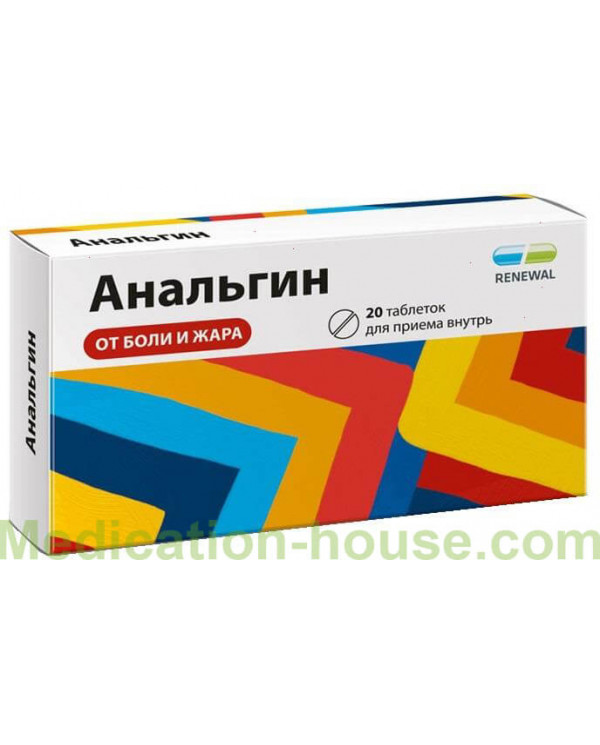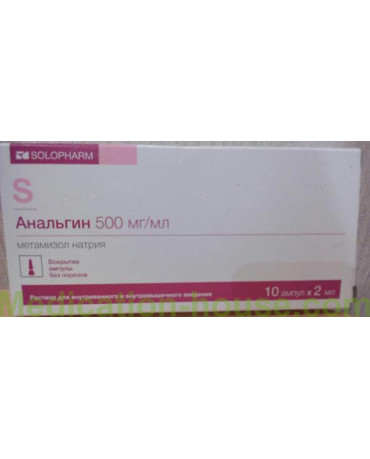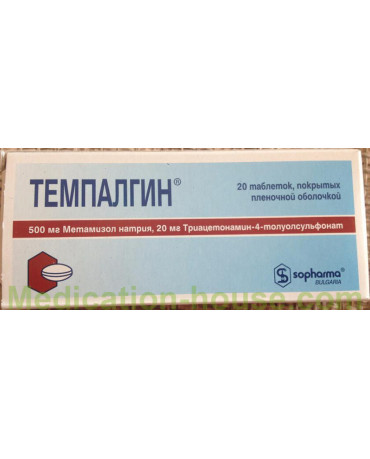User manual for Analgin
You can buy Analgin on this page
Analgin is used as an analgesic or antipyretic drug to relieve pain and normalize body temperature, provoked by any reason.
Unlike other drugs of the NSAID group, Analgin has a minimally pronounced anti-inflammatory effect, therefore it is practically not used to reduce inflammation of any localization.
In this article we will consider why doctors prescribe the drug Analgin, including instructions for use, analogues and prices for this drug in pharmacies. Real REVIEWS of people who have already used Analgin can be read in the comments.
Composition and release form
According to the instructions for use Analgin is available in tablets, rectal suppositories and ampoules (solution for intramuscular and intravenous administration). For children, analgin is produced in the form of a rectal suppository and tablets.
Active ingredient: metamizol sodium salt; 1 tablet contains Metamizole Sodium Salt 500 mg; potato starch, calcium stearate, talc.
Usually, all types of the drug are simply called “Analgin”, but in some cases, when it comes to a particular dosage form, a clarifying word is added, for example, “Analgin for children”, “Analgin tablets”, “Analgin candles”, “Analgin injections " etc.
What helps Analgin?
The use of Analgin helps with pain syndromes of different origin: headache and migraine pain, neuralgia, myalgia, toothache, algomenorrhea, chorea, rheumatism, radiculitis, fever caused by infectious and inflammatory diseases.
Also, the drug is used in surgical practice to eliminate postoperative pain. For renal and biliary colic, the use of Analgin is effective in combination with antispasmodic drugs.
pharmachologic effect
It is a derivative of pyrazolone. It is characterized by a pronounced analgesic, antipyretic and minor anti-inflammatory action.
Anti-inflammatory effect of metamizol is also caused by inhibition of prostaglandin production.
The antipyretic effect of Analgin is ensured by the ability to reduce production and release of chemical substances that affect heat production.
Analgesic action is provided by the ability of the active substance to inhibit cyclooxygenase and the synthesis of prostaglandins (they take part in the development of inflammatory and pain reactions). In addition, Metamizole blocks the transmission of pain impulses and increases the threshold of sensitivity of pain centers, reduces the response of brain structures to pain caused by a particular irritant.
Analgin also has an antispasmodic effect on the smooth muscles of the biliary and urinary tract.
Instructions for use
According to the instructions for use prescribed analgin inside, intramuscularly or intravenously. The dosage depends on the intensity of pain, fever and individual reaction in response to taking Analgin. The smallest effective dose controlling pain and fever should be chosen. Tablets should be swallowed whole, with a sufficient amount of liquid (for example, a glass of water).
Inside taken after meals. Dose for adults - 0.25-0.5 g 2-3 times a day; with rheumatism - up to 1 g 3 times a day. Children inside - 5-10 mg / kg 3-4 times a day.
Intramuscularly or intravenously (with severe pain) is administered to adults in 1-2 ml of 50% or 25% solution 2-3 times a day; no more than 2 g per day. Children are administered at the rate of 0.1-0.2 ml of a 50% solution or 0.2-0.4 ml of a 25% solution per 10 kg of body weight.
Higher doses for adults inside: single - 1 g, daily - 3 g; intramuscularly and into a vein: single - 1 g, daily - 2 g. High doses should be avoided with reduced renal or hepatic function. Perhaps short-term use without dose reduction. Prolonged use is not possible. Long-term treatment requires regular blood monitoring, including counting of white blood cells.
Contraindications
The annotation lists the following contraindications to the use of Analgin:
hypersensitivity to metamizole sodium, to other components of the drug and / or pyrazolone derivatives (propifenazone, aminophenazone, phenazone);
hematopoietic oppression (agranulocytosis, neutropenia, leukopenia);
anemia, including hereditary hemolytic anemia associated with a deficiency of glucose-6-phosphate dehydrogenase;
asthma caused by acetylsalicylic acid;
renal and / or liver failure;
pregnancy;
breastfeeding period;
age up to 15 years.
In pediatric practice, tablets are used from the age of ten, suppositories in children older than one year. Intramuscular medication should not be administered to children up to three months, as well as children weighing up to five kilograms. Contraindications for intravenous administration of Analgin are children from three to eleven months.
Side effects
Side effects when using Analgin can manifest as:
On the part of the urinary system: renal dysfunction, oliguria, anuria, proteinuria, interstitial nephritis, urine staining in red.
From the side of blood-forming organs: agranulocytosis, leukopenia, thrombocytopenia.
Allergic reactions: urticaria (including on the conjunctiva and the mucous membranes of the nasopharynx), angioedema, in rare cases - malignant exudative erythema (Stevens-Johnson syndrome), toxic epidermal necrolysis (Lyell's syndrome), bronchospastic syndrome, anaphylactic shock.
Other: decrease in blood pressure. Local reactions: with intramuscular injection, infiltrates are possible at the injection site.
Terms and conditions of storage
The drug is stored in its original packaging, protected from sunlight and moisture, out of the reach of children at a temperature not exceeding 25 ° C. The shelf life of tablets Analgin is 5 years. Do not use the drug after the expiration date indicated on the package.
Terms of sell
The prescription is not required to buy Analgin.





